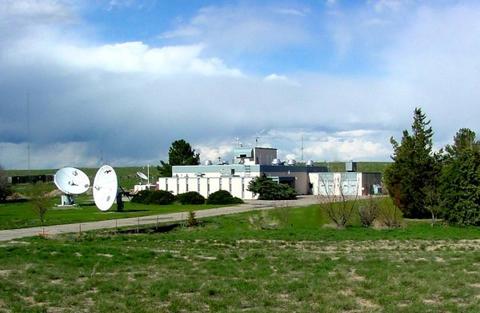Radio Station WWV
Notice:
Since November 15, 2021, WWV and WWVH has been broadcasting a test signal on minute 8 of each hour on WWV, and minute 48 on WWVH. This signal has been created to assist in ionospheric research, and is a joint effort of the Ham Radio Citizen Science Investigation (HamSCI) and NIST. The signal consists of various tones, chirps, and Gaussian noise bursts. The signal may be modified occasionally. For more information on HamSCI and the WWV/WWVH project, click here.

NIST radio station WWV broadcasts time and frequency information 24 hours per day, 7 days per week to millions of listeners worldwide. WWV is located near Fort Collins, Colorado, about 100 kilometers north of Denver. The broadcast information includes time announcements, standard time intervals, standard frequencies, UT1 time corrections, a BCD time code, and geophysical alerts.
Broadcast Frequencies
WWV operates in the high frequency (HF) portion of the radio spectrum. The station radiates 10 000 W on 5 MHz, 10 MHz, and 15 MHz; and 2500 W on 2.5 MHz and 20 MHz. Each frequency is broadcast from a separate transmitter. Although each frequency carries the same information, multiple frequencies are used because the quality of HF reception depends on many factors such as location, time of year, time of day, the frequency being used, and atmospheric and ionospheric propagation conditions. The variety of frequencies makes it likely that at least one frequency will be usable at all times.
Antennas
The WWV antennas are half-wave vertical antennas that radiate omnidirectional patterns. There are antennas at the station site for each frequency. Each antenna is connected to a single transmitter using a rigid coaxial line, and the site is designed so that no two coaxial lines cross. Each antenna is mounted on a tower that is approximately one half-wavelength tall. The tallest tower, for 2.5 MHz, is about 60 m tall. The shortest tower, for 20 MHz, is about 7.5 m tall. The top half of each antenna is a quarter-wavelength radiating element. The bottom half of each antenna consists of nine quarter-wavelength wires that connect to the center of the tower and slope downwards to the ground at a 45 degree angle. This sloping skirt functions as the lower half of the radiating system and also guys the antenna.
WWV Antenna Coordinates
| Frequency (MHz) | Latitude | Longitude |
|---|---|---|
| 2.5 | 40° 40' 55.2" N | 105° 02' 31.3" W |
| 5 | 40° 40' 42.1" N | 105° 02' 24.9" W |
| 10 | 40° 40' 47.8" N | 105° 02' 25.1" W |
| 15 | 40° 40' 45.0" N | 105° 02' 24.5" W |
| 20 | 40° 40' 53.1" N | 105° 02' 28.5" W |
Modulation
The signals broadcast by WWV use double sideband amplitude modulation. The modulation level is 50 percent for the steady tones, 50 percent for the BCD time code, 100 percent for the second pulses and the minute and hour markers, and 75 percent for the voice announcements.
Experimental 25 MHz WWV Broadcast
WWV has resumed broadcasting on 25 MHz on an experimental basis. The broadcast consists of the normal WWV signal heard on all other WWV frequencies, at the same level of accuracy.
Current 25 MHz Broadcast Specifications
Schedule: typically continuous. As an experimental broadcast, the 25 MHz signal may be interrupted or suspended without notice.
Radiated Power: 2.5 kW
Antenna: half-wave vertical dipole. Coordinates: 40° 40' 50.5" N, 105° 02' 26.6" W
Listener comments and reception reports may be emailed to: wwv [at] nist.gov (subject: , body: ) (wwv[at]nist[dot]gov), or sent via postal mail to:
National Institute of Standards and Technology
Radio Station WWV
2000 E. County Rd. 58
Fort Collins, CO 80524
Contacts
-
NIST Radio

